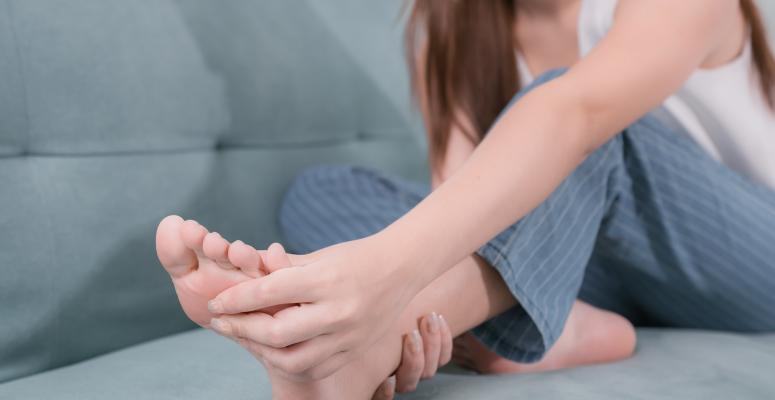
Systemic lupus is a chronic autoimmune disease that can cause a wide range of symptoms, including joint pain, swelling and stiffness. These symptoms can have a significant impact on daily life, especially when they occur in the feet.
Foot pain is a common complaint among people with lupus, and it can range from mild discomfort to severe pain and disability. Whether you have recently been diagnosed with lupus or have been living with it for years, it is important to understand the causes of lupus-related foot pain and the available treatments. With the right treatment plan — which in many cases includes physical therapy — many people with lupus can find relief from their foot pain and maintain an active and fulfilling life.
Why does lupus cause foot pain?
Lupus is a chronic autoimmune disease that causes the body's immune system to attack its own healthy tissue and organs. This can result in inflammation and damage to various parts of the body, including the skin, joints, kidneys, heart, lungs, brain and blood cells.
There are several different types of lupus, but the most common form is systemic lupus erythematosus (SLE), which can affect many parts of the body. Lupus can be difficult to diagnose because its symptoms are similar to those of many other illnesses and can come and go. Common symptoms include fatigue, joint pain and swelling, skin rashes, fever, and sensitivity to light.
When lupus affects the joints, it can cause inflammation and pain. This can result in foot pain, especially in the heels, ankles and soles of the feet. The inflammation can cause the joints to become stiff and swollen, making movement difficult and painful. Unfortunately, many lupus patients report having foot pain that restricts their daily lives and sleeping patterns.
In addition to joint pain in the foot, lupus can also cause other symptoms in the feet, such as numbness, tingling and sensitivity to cold. In particular, lupus is linked to foot pain for several reasons, especially because it can cause:
- Joint inflammation — Lupus can cause inflammation in the joints that mimic arthritis symptoms, which can result in pain, swelling and stiffness in the feet.
- Vasculitis — Lupus can cause inflammation in the blood vessels, which can lead to decreased circulation and pain in the feet. This can especially make your feet feel cold.
- Soft tissue inflammation — Lupus can affect the soft tissue in the feet, such as the muscles, tendons and ligaments, resulting in pain and decreased mobility.
- Neuropathy — Lupus can affect the nervous system, causing numbness, tingling and pain in the feet.
It's important to note that foot pain is a common symptom in many conditions, not just lupus, so a proper diagnosis from a doctor is necessary to determine the cause of the pain. If you have lupus and are experiencing foot pain, it's important to talk to your doctor about proper treatment and management options.
How can physical therapy help ease lupus-related foot pain?
Physical therapy can be a beneficial option for managing lupus-related foot pain. A physical therapist can help determine the specific underlying causes of your foot pain, develop a customized treatment plan that addresses these issues, and work with you to achieve your goals. With the right treatment plan, physical therapy can be a safe and effective way to manage lupus-related foot pain and improve quality of life. Physical therapy can offer the following benefits while managing foot pain with lupus:
- Stretching and strengthening exercises — Physical therapists can design a personalized exercise program to target specific muscles and joints in your feet, helping to improve flexibility, range of motion and strength. These exercises can help reduce lupus-related foot pain and prevent future injury.
- Manual therapy — Physical therapists can use various manual techniques such as soft tissue mobilization to stimulate soft tissue in the feet, reduce muscle tension, improve joint mobility and ease pain.
- Foot and ankle bracing — Physical therapists may recommend the use of supportive devices such as braces or orthotics to help improve your foot alignment and limit unnecessary strain on your feet.
- Therapeutic modalities — Physical therapists may use modalities such as dry needling, the Graston Technique®, and kinesiology taping to reduce pain and inflammation in your feet.
- Education — While lupus symptoms are chronic, physical therapists can provide education on proper foot care, including tips for reducing foot pain during daily activities and ways to prevent future foot pain.
Alliance PTP is ready to help you find top-notch PT for your lupus-related foot pain
Lupus can lead to a variety of uncomfortable symptoms, and foot pain is one of them. Physical therapy can help you deal with foot pain symptoms so that you can get through your daily routine with minimal discomfort. At Alliance Physical Therapy Partners, we can connect you with a local physical therapist so that you can get the high-quality PT you need.
Want to see a physical therapist in person? We can put you in touch with an Alliance PTP partner that’s close to you and that can help you address your lupus-related foot pain.
Not keen on in-person PT sessions or not close to an Alliance PTP partner? No worries. We also offer effective and affordable virtual physical therapy through our Agile Virtual Physical Therapy platform.
Come find help for your chronic condition today!
Get Help at a Location Near You
